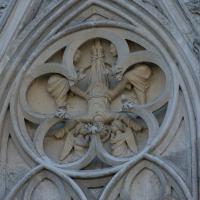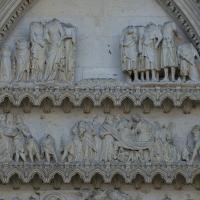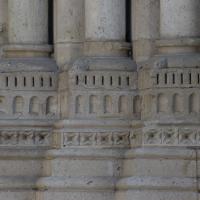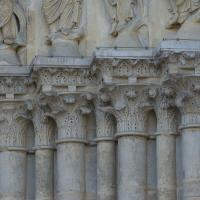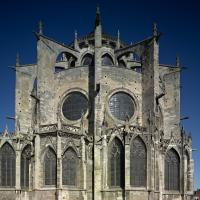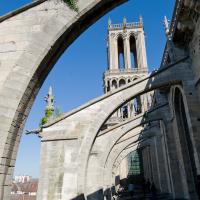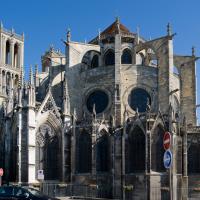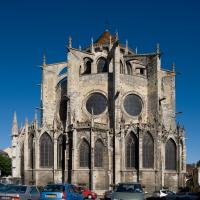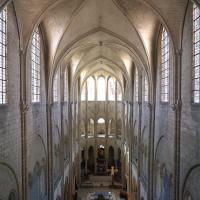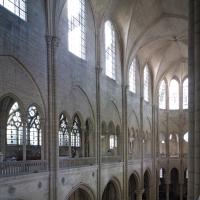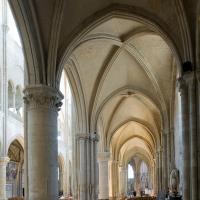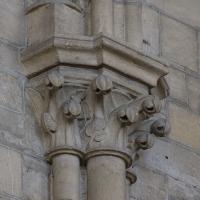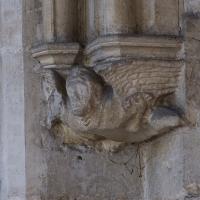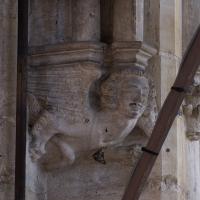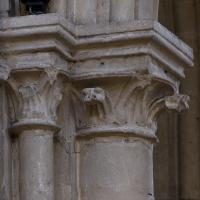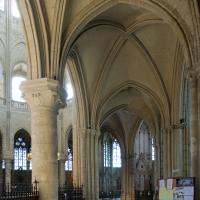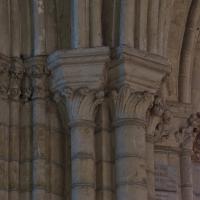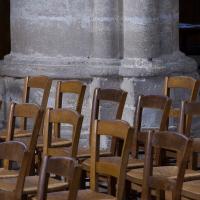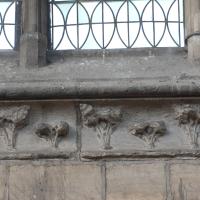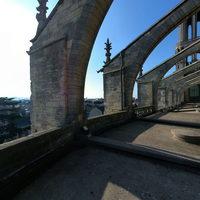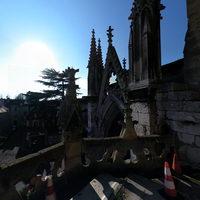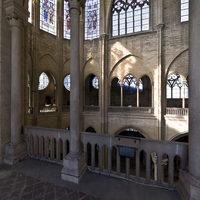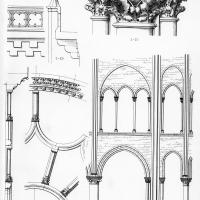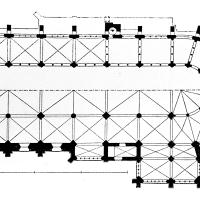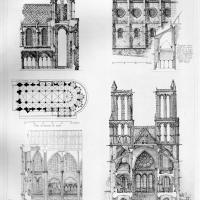Images
VR Tour
Notes
History
The town of Mantes (Medanta) had its origin in a Carolingian port, yet very little is known until the eleventh century when it assumed some importance in relation to its castle (castellum) and control of navigation on the river Seine. In the 1070s Simon, Count of Vexin, conceded the collegiate church of Notre-Dame (here mentioned for the first time) to the abbey of Cluny. The town (bourg) had been controlled by the counts of Vexin: having been seized and burnt by William the Conquerer (1087) the town became a key fortified position in the struggle between the Dukes of Normandy and the Capetian kings: the château was beseiged and the town captured in 1110 by Louis VI who soon afterwards granted a commune, confirmed by Louis VII in 1150. The church of Notre-Dame was a collégiale castrale, linked with the Capetian palace: Henri de France, brother of Louis VII was abbot between 1135 and 1145. Henri was succeeded by his brother Philippe de France who later became archdeacon at Notre-Dame of Paris. Louis VII and Philip Augustus were abbots of the collégiale. The sumptous chapel of Saint-Paul Saint-Louis with its refined Parisian-rayonnant forms was added to the south flank of the choir after 1313 and the Portail des Echevins, with its close links with the transept of Rouen Cathedral, (southern portal of the western frontispiece) was inserted in the second or third decade of the fourteenth century
Date
Begun ca. 1160
Plan
The six bays of the nave are gathered under three sexpartite rib vaults; the aisles flanking the main vessel are covered with quadripartite vaults. There is no transept, and to the east a seven-segment hemicycle circled by ambulatory and (added) radiating chapels. The nave is terminated to the west by a non-projecting transept, recalling Soissons Cathedral and a ?harmonious façade? with twin towers and triple portal.
Elevation
The three-story elevation is quite homogenous with spaceous gallery and small clerestory. Noteworthy are the transverse barrel vaults in the gallery of the hemicycle.
Chronology
In order to create the site for the Gothic church it was first necessary to build up the terrace on the river slope on the north flank; work then began on the north-west tower and lowest parts of the west frontispiece. Aisles and ambulatory were then built: similarities with Senlis Cathedral, begun , suggesting a mid-century start of work. The main arcade, with its pronounced alternation was then built, working from west to east. Bony remarked a sharp change at the level of the gallery, when construction became much thinner; it is thought that it was at this point that the system of flying buttresses was introduced (they sit porte-à-faux on the gallery vaults). The model then shifted from Senlis cathedral to Notre-Dame of Paris, . The upper western frontispiece, with its similarities with Laon Cathedral, may be dated after 1200.
Sculptural Program
The west façade of the Collégiale Notre-Dame at Mantes-la-Jolie contains three sculpted portals. The north and central portal remain in their original state from the 1170s. The south portal was replaced around the year 1300 by a larger, more ornate portal in the Court Style. Topped by a high crocketed gable with lacey open-work tracery, it dominates the façade and draws the eye away from the earlier twelfth-century portals. Clearly modeled off the Portail de la Calende at Rouen Cathedral, and probably executed by the same workshop, it displays events from the life of Christ and his Crucifixion. Though now heavily damaged, the lowest lintel shows, from left to right, the Annunciation, Visitation, Nativity, Annunciation to the Shepherds, and the Three Magi. The second register is heavily damaged, but if we look to the Rouen prototype, we can assume that the narrative progresses from left to right with the Betrayal of Christ, the Flagellation, the Carrying of the Cross, then, leaving the Crucifixion for the prominence of the tympanum, moves to the Three Marys at the empty tomb, followed by the Harrowing of Hell. The tympanum, also severely damaged, would have shown the Crucifixion, though Christ on the cross is now entirely missing. The archivolts display in two bands various Old Testament figures and prefigurations of Christ. The trumeau and jamb sculptures are all now missing.
The north portal, dating from the 1170s, shows Christ's Ascension, and on the lintel we can discern Christ's tomb, lid askew, with the angel seated beside it pointing to its empty depths. In the center are two figures in armor with swords and shields, stacked horizontally. On the right are the three Marys approaching the tomb with jars of ointment. The tympanum shows Christ enthroned, his hands placed on a book and a globe, flanked by two censing angels. The single band of voussoirs shows standing figures of prophets with scrolls. The trumeau and jamb sculptures are all now missing.
The central portal, once the grandest of the three, was also executed in the 1170s, and depicts the Coronation of the Virgin. The lintel shows, on the left, the Virgin's Dormition, with her body gently lowered into its tomb observed by a crowd of mourning apostles. The right side of the lintel shows her Assumption, where angels surround her tomb and reach down to lift her out. In the center a figure of Christ is shown carrying a small child, in reference to the soul of the Virgin which he brought up to Heaven. The tympanum, heavily damaged, shows Christ and the Virgin enthroned side by side under an architectural canopy. Flanked by four angels, a fifth angel would have originally been portrayed above the seated figures in the act of crowning the Virgin. The voussoirs show the Tree of Jesse in four bands. The jamb figures are now all missing.
The two twelfth-century portals belong to the work of an atelier also most likely responsible for work at Senlis and Paris, most notably the Porte des Valois at Saint-Denis. The north portal refers formally to the Porte des Valois, with a similar doorway shape, figural style, and foliate band edging the voussoirs. The Coronation theme of the central portal, still relatively new for portal sculptures, was first used at Senlis. The popularity of this imagery, its association with the maternal nature of the Virgin and of her role as bride of Christ as described in the Song of Songs, led to its depiction in sculpture on façades throughout northern France by the mid-13th century. The portal at Mantes is one of the earliest to show a link with the Senlis façade, both in the layout and style of its tympanum and lintel, and in its unfurling motif of the Tree of Jesse in the voussoirs. Though the figures are fairly damaged, we can still see that their twisting, active pose and drapery points to the Senlis prototype.
Significance
The architectural forms of Notre-Dame de Mantes point successively to Senlis, Notre-Dame of Paris and finally to Laon and Soissons. The mid-12th century triple portal of the western frontispiece, contemporaneous with the royal portal of Chartres Cathedral, already announces the ambitions of the builders. Links with the Porte des Valois of S-Denis have also been detected. The most memorable phases of construction involves the extraordinarily slender and brightly-lit superstructure stiffened by transverse barrel vaults (an unusual solution!) at gallery level and supported by slender flying buttresses. Notre-Dame de Mantes, like Senlis Cathedral is a central building in the group of churches with direct links to the Capetian monarchy
Location
Bibliography
Baron, F., "Les statuettes de la chapelle dite "de Navarre" à Notre-Dame de Mantes," Bulletin de la Société nationale des antiquaires de France, 1997, pp 266-274
Barruol, A.; Dufay, B.; Ducreux, A.-C.; Erlande-Brandenburg, A., Mantes médiévale: la collégiale au coeur de la ville, Paris, c2000
Bony, J., "La collégiale de Mantes," Congrès archéologique, 1947, 163-217.
----, Notre Dame de Mantes, Paris, ?
Bresson, L., "La chapelle royale de Navarre de la collédiale Notre-Dame de Mantes," Le Mantois: Bulletin de la Société des amis du Montois, vol. 28, 1977, pp 3-7
Caviness, M. H., "A man with a dragon from one of the tribune occuli of Mantes," Gesta, vol. 25:1, 1986, pp 127-134
Durand, A., La chronique de Mantes: ou histoire de Mantes depuis le IXe siècle jusqu'à la Révolution, Mantes, 1883
Gallet, Y., "Les chapelles du chevet de la collégiale de Mantes. Un petit chef-d'oeuvre du gothique rayonnant," Bulletin monumental, vol: 163:2, 2005, 101-114
Géraud, M.-C., Une joie toute simple: meditation sur le portail du Christ en gloire de la collégiale de Mantes-la-Jolie, Mantes-la-Jolie, 1997
Prache, A., "L'architecture de la collégiale de Mantes au XIIe siècle," Bulletin de la Société nationale des antiquaires de France, 2001, pp 174-175
Rhein, A., Notre-Dame de Mantes, Paris, 1932
Walter, E., "Etude de l'élévation d'une travée de la nef de Notre-Dame de Mantes," Le Mantois: Bulletin de la Société des amis du Montois, vol. 21, 1971, pp 21-26

















